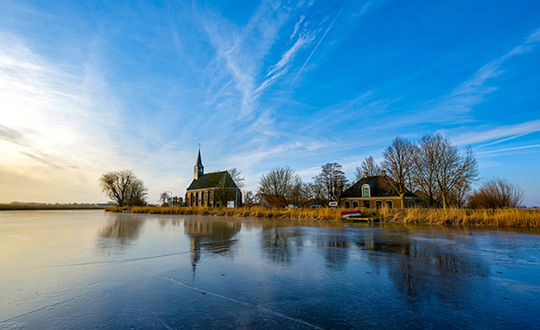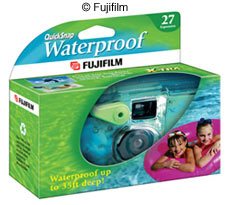
If you're thinking about heading someplace warm this winter, or if you're lucky and the summer season is just starting where you live, why not dip your big toe into underwater photography? You don't need to buy any expensive equipment if you just want to experiment. If this is your first attempt, you can get started by purchasing any of the waterproof single-use underwater cameras on the market.
This is a great place to start, especially since some of these single-use cameras are water-safe to 50 feet. The latest single-use waterproof models from Kodak come with 800 Max Film, the most versatile of Kodak films, since it works well in bright sunlight as well as lower light levels. Fuji also makes an underwater camera loaded with ISO 800 speed film that rated to a depth of 35 feet.
If you're ready to invest in a reusable underwater camera, we'll tell you about a few of the models we like later on.
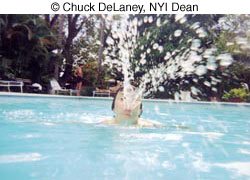
There's a lot to learn if you get serious about underwater photography. This article isn't intended to be a thorough introduction to this complicated subject. Particularly if you want to take a camera along on scuba dives and work at great depths, there's a lot to learn and you'll find that some of the recognized dive organizations also offer very good photography lessons. In this article, we really want to get those of you who might be in the pool or surf interested in the possibilities of using a camera as part of your recreational swimming or skindiving.
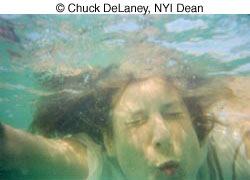
A waterproof single-use model is perfect for candid photos of your friends playing around in the pool. You can use them for interesting results above the water or under it. With a little experimentation, you can even take a photo that's half above the surface and half submerged, like the photo below.
When you head out to the beach, you should consider leaving your expensive SLR camera at home, since salt and sand are the natural enemies of the innards of any camera. That includes your film or digital point-and-shoot cameras too! With a waterproof model in your hand, you will have the option of chasing your frisky pooch or hyper child into the water without damaging your camera.

One slip by the pool and you could see your precious SLR free fall to the deep-end. Who needs that stress when you're on vacation? So don your snorkel, scuba, or swimming goggles and head to the nearest body of water, be it your neighborhood swimming pool, beach, or maybe you've got a really big bathtub. Our underwater photography tips will ensure that you take great photos wherever you are.
Take Care!
Since you are not an amphibian, a few obstacles underwater that wouldn't befuddle you on land might distract you underwater. Your body will feel like it's moving in slow motion. It's important to keep an eye out for nasty predators that are around you, be they Man-o-war jellyfish or Boogie boarders. As much as you want that perfect vacation shot, you do not want to start your trip off on the disabled list. It's easy to become so fascinated with what's happening in front of your camera that you neglect what's going on behind your back.
The best time to take underwater photos is between 10am-2pm, because this is when the sun is directly overhead. At this time you will get optimal sunlight. If you go snorkeling and stay close to the shore and find the underwater scenery somewhat Spartan, you can ask a friend to come along with you to be an underwater model. (Someone with good lungs who isn't camera shy!)
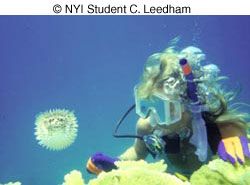
One of the most common mistakes land photographers make when they are first exploring underwater photography is shooting from too far away. Remember that when you're underwater your vision is off. Looking through a face mask, everything appears about 25% closer than it really is.
So if you spot a colorful fish, eel or other creature, move in close to make up for this. The NYI Guidelines apply underwater too. Remember: Simplify! Don't be bashful with your finned friends, get in close, and fill up the frame with your subject to capture a memorable photo. This will reduce the amount of water you have to shoot through, which will improve your photo especially if the water isn't that clear.
Another thing that can surprise rookie underwater photographers is the loss of color and light as you plunge down. You lose color very quickly underwater. The reds are the first to go. The further down you go, the more muted the colors will be till your girlfriend's bikini goes from fire engine red to grayish blue. If your camera has a built-in flash use it: This will help bring out the bathing suit's real color.
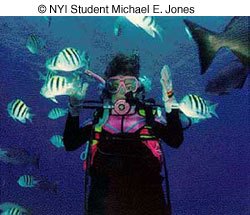
Silhouettes in the water can be very powerful images. Do you want your model to appear dark against the sun-lit water? Then you should make sure the sun is in front of you, if possible behind your model. If you want to showcase your subject's wild color and have the background appear dark and foreboding, then keep the sun behind you.
We interviewed two NYI graduates who are successful professional underwater photographers, Ian Lauder and Jim Edds. Recently, Rodale's Scuba Diving Magazine named Ian "Photographer of the Week." (Check out Ian's photography at his own Web site, www.cyber-sea.com). Ian was on his way to Maui to photograph wildlife when we caught up with him. We asked him what mistakes he made when he first started shooting underwater. Besides giving us the tips about distance and color that we mentioned earlier, here are some added tips from Ian.
Don't shoot down unless you have a good reason, like wanting to shoot dark subjects on a white sandy bottom.
Shoot at an upward angle to capture a more dramatic image.
Learn the capabilities of your camera setup.
Be aware of dive gear, kelp, bubbles, etc. floating in front of the lens.
Isolate the subject from the background so it stands out.
Most motion is slower under water, so you should keep this in mind if you are using SLR, when selecting your shutter speed.
Ian uses Fuji slide film in blue water and Kodachrome slide film ISO 64 or 200 in green water. Fuji films can make the water look a little bluer, but Kodachrome can give you a more realistic color.
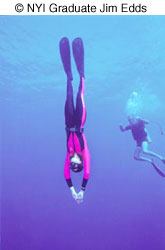
Another NYI graduate who has made a name for himself in underwater photography is Jim Edds in Florida. His photos of free diving champion and fashion model Mehgan Heaney-Grier, one of which is show above, have circled the globe. He had a full-page image of Mehgan published in People magazine and the London Times. He hobnobbed with Club Medders in Sardinia at the Second Free Diving Competition. The photos he took of the competitors were published in ESPN's magazine.
Most of the time, Jim's film of choice is Fuji 100 film. He uses an aluminum housing made by Aqua Vision Systems. "The trick is to shoot close with a wide angle with an autofocus camera because depth-of-field underwater is very unforgiving," says Jim.

Have you ever dreamed of free diving in a Florida swamp to look for alligators to cuddle up with? In this photo Jim took, the brave man named "Manny" appears to be tickling the gator. Jim tells us that Manny has been interacting with gators since he was a kid and figured out that approaching them underneath like this was not threatening, but touch the gator on top of the nose and you will get the opposite reaction.
(Do not try this at home!) This photo appeared in Playboy Germany. Jim used Kodak 400 speed film for this shot, as there's not much light in the swamps. By the way, much of Jim's current work is as a weather videographer. He chases storms and recently had hurricane footage appear on

The Weather Channel and the Discovery Channel.
Hint for landlubbers: Maybe you don't even like to swim, and the idea of free diving in a clear blue ocean or a muddy swamp strikes you a foolhardy. You can use your regular camera and take some great photos of animals and fish that are underwater while you stand safe and dry on terra firma. How? Just visit your local zoo and aquarium where you can photograph your subjects underwater, like these two hulking creatures. Just watch the lighting. Either don't use your camera's flash, or if you do, make sure you're not perpendicular to the glass surface because you'll get a nasty reflection. Shooting through glass works best if your flash is 30-degrees or more off perpendicular.
Underwater Cameras
If you feel very comfortable fathoms deep among the fish and you want to go beyond the single-use cameras, there are a number of underwater cameras — both film and digital —as well as specific accessories that can add to your underwater photography experience. For the beginning underwater photographer there are reusable underwater point-and-shoot cameras on the market that are modestly priced so you won't have to dip into your nest egg.
There are a few things to consider before buying an underwater camera. How much do you want to spend? How deep are you going to go? Do you want to buy an underwater film camera or a digital model?
Underwater Film Cameras
Bonica makes a number of 35mm underwater cameras. The Bonica Handy Snapper has a 30mm f/5.6 focus-free lens, a built-in electronic flash, a large viewfinder plus an external viewfinder attachment. It's sealed with a silicone O-ring and is rated to a depth of 100 feet. A more advanced model, the Bonica Multi-Snapper has macro capability, can withstand a depth of 165 feet, and has a host of other features. It comes with a vacuum pump to assure that the camera is sealed before you take it underwater. They also make the Sea King II and Sea Explorer cameras and accessories such as a Neon Strobe Light which is an off-camera strobe you can attach to the camera or hold in your hand to enhance picture quality in poorly lit areas.
Sea & Sea USA makes another popular entry level underwater point-and-shoot camera, the MX-5 II. This 35mm film camera features a 28mm f/9 lens and a pop-up sportsfinder to help you see what you are photographing underwater. Additional accessories include a close-up lens and a detachable strobe.
Minolta makes an autofocus underwater camera, the Minolta Vectis Weathermatic Zoom that takes APS film. It's submersible to 33 feet and has a 30-50mm zoom lens (equivalent to a 38-63 lens for 35mm film.) It also has a built-in flash. It takes the Minolta Xtreen series of accessories which are specifically designed for high-action sports photography.
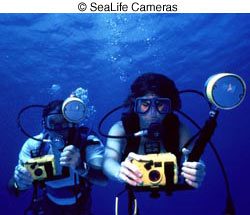
Another company that makes underwater cameras for beginners is SeaLife who offers several models including the SeaLife Sportdiver which is a basic model that you can buy for under $100 dollars. They also make more advanced cameras in the Reefmaster line, many of which come in kits complete with closeup lenses, underwater filters, and carrying cases.
Other popular underwater cameras include the Canon Elph and the Canon SureShot A1 both rated to work to 16.4 feet; Epoque's ET-30S (99 feet); and Ikelite’s Auto 35 (125 feet.)
By the way, for years, people who were serious about underwater photography and wanted to take it to the highest level bought an underwater camera called the Nikonos. Unfortunately, the line has been discontinued by Nikon though you may still be able to find one online. Many companies are still making housings and other accessories for it.
Underwater Digital Cameras
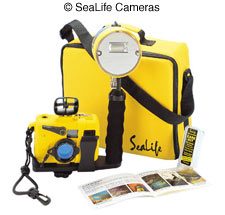
Digital cameras have begun to make their mark in underwater photography too, and there are now several underwater digital point-and-shoot cameras available in the 2-3.3 megapixel range.
There are a number of distinct advantages for using digital cameras underwater. Many digital cameras offer considerably more depth-of-field than film cameras because of their smaller than 35mm CCD chips. This is a definite help when photographing underwater since greater depth-of-field means more of your image will be in focus. Digital cameras tend to feature macro capabilities that focus more closely than film cameras, allowing you can get even closer to small objects like tiny fish and coral. Some underwater photographers feel that digital camera images have more realistic ocean blue colors than they can get using film. Many also feel that digital cameras while not recording highlight detail as well as film, offer much better detail in shadow areas, a definite advantage underwater where little sunlight reaches. The instant feedback offered by a digital camera means you can easily decide whether or not you need to reshoot while still in the water. Keep in mind too, that all these advantages we've just mentioned are available in many digital point-and-shoot models, not just professional-quality expensive digital SLRs.
However, there are some issues with digital cameras that you do need to consider when photographing underwater. Shutter delay — the time it takes for the camera to take the picture after you depress the shutter button — can result in you missing those great action shots of the shark eating a school of fish. You‚Äôll also find digital cameras take more time to be ready to take the next photo, so you're not going to be able to capture a sequence of photographs as quickly as you will with a film camera.
If you decide to go digital here are a couple of popular models:
SeaLife offers three digital models including the Reefmaster DC250 which is a 2.1 megapixel camera, and the Reefmaster DC300, a 3.3 megapixel model. Both feature what SeaLife calls "Land & Sea Exposure Modes" which basically means that the cameras can be used both in the water and out. When used underwater, the Sea Exposure modes offer specific shutter speeds and aperture settings that take into account the low lighting conditions found in water.
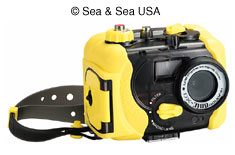
Sea & Sea USA makes the AquaPix digital camera which can also be used on the land or underwater. Sea & Sea is so sure that the camera is waterproof that it offers an insurance policy against water damage. The camera also features a switch allowing you to flip between the built-in closeup lens or built-in color correction filter.
Underwater Housings
Another possibility is to put the camera you own, either film or digital, into an underwater housing. What are housings? You will hear a lot about these glass and metal things in the underwater world. Housings are camera protectors made of glass and metal that fit snuggly around your film or digital cameras and lenses to protect them from the water.
Ikelite makes housings that work with a wide variety of cameras but you'll need to buy the one that is specifically designed for your camera model. Ikelite also makes an underwater camera as well as flash gear and accessories.
Nexus makes aluminum housings for Nikon film and digital cameras and lenses as well as for Olympus' digital cameras.
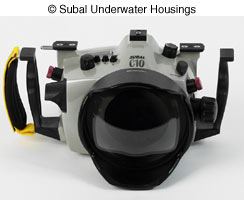
Subal has underwater housings for film or digital SLR cameras by Nikon, Canon, and Fuji.
Ewa-Marine makes a different type of housing. They are flexible and look like a plastic bag with a glass filter attachment you screw on to your lens. Just like other housings, they are model specific. However, they can be less expensive than metal housings. Depending on the model, Ewa-Marine's housing can keep your camera safe at depths of 20 to 150 feet.
Underwater photography can be a lot of fun, so the next time you are near the water or a pool, consider grabbing a camera (and the proper protection for it) and jumping in!



